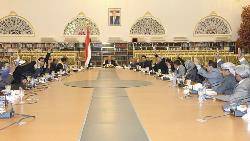A presidential panel has agreed to transform Yemen into a six-region federation as part of its political transition, state news agency Saba reported.
The final approval on creating a "federal state of six regions" came at a meeting of the panel, headed by President Abd-Rabbu Mansour Hadi and including representatives of Yemen's main parties, Saba said on Monday.
Hadi formed the committee in late January at the end of a "national dialogue" to decide on the number of regions, and to insert it into the text of a new constitution, to be drafted and voted on within a year.
The six agreed regions include four in the north - Azal, Saba, Janad and Tahama - and two in the south, Aden and Hadramawt.
The southeastern Hadramawt province would include al-Mahra, Shebwa and the island of Socotra, while Saba comprises Bayda, Marib, and Al-Jawf.
Azal would include the provinces of Dhamar, Amran and Saada, a rebel stronghold, while Aden would comprise the capital of the former south, as well as Abyan, Lahej and Daleh, the news agency reported.
'Special status'
The capital city of Sanaa will not be affiliated to a region and will have "a special status in the Constitution to guarantee its independence and impartiality", said the state news agency.
Janad would include Taez and Ibb, and Tahama also takes in Hudaydah, Rima, Mahwit and Hajja.
Yemen's parties had been divided on whether to split the future federation into two or six regions. The government feared that a straight north-south divide could set the stage for the disgruntled south to secede.
Hashem Ahelbarra, Al Jazeera's Yemen correspondent, said that even with the decision, which is step forward for the country's democracy, it will still face problems in the future.
"It shows that people in the north, who consider themselves the political elite in Yemen, still insist that they have to become and stay as a majority and therefore they were granted four provinces in the federal system," he said, adding that doubted the southerners would accept the system.
The decentralization of power aims to meet southerners' demands for autonomy.
Southern parts of Yemen formed an independent state from the end of British colonial rule in 1967 until union with the north in 1990.
A secession attempt four years later led to a brief but bloody civil war that ended with northern forces taking over the south.
Yemen's national dialogue was stipulated by a UN-backed roadmap that ended a year of protests against former president Ali Abdullah Saleh, who stepped down in 2012 after 33 years in power.
PHOTO CAPTION
Yemen's President Abd-Rabbu Mansour Hadi (C) and a presidential panel raise their hands to vote on the final approval on transforming Yemen into a federal state of six regions in Sanaa February 10, 2014, in this handout photo provided by the Defense Ministry.
Al-Jazeera


 Home
Home Discover Islam
Discover Islam Quran Recitations
Quran Recitations Lectures
Lectures
 Fatwa
Fatwa Articles
Articles Fiqh
Fiqh E-Books
E-Books Boys & Girls
Boys & Girls  Articles
Articles










